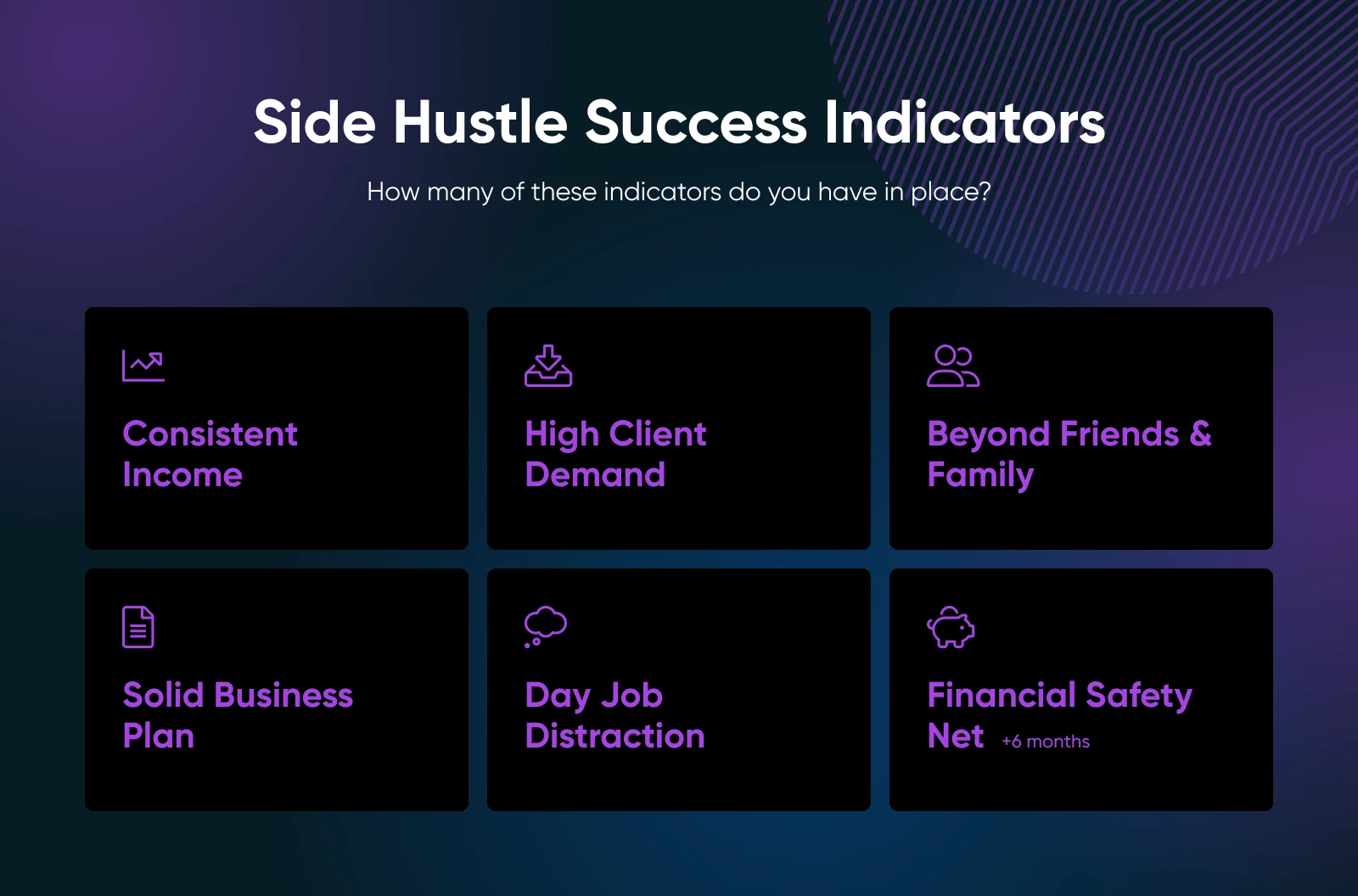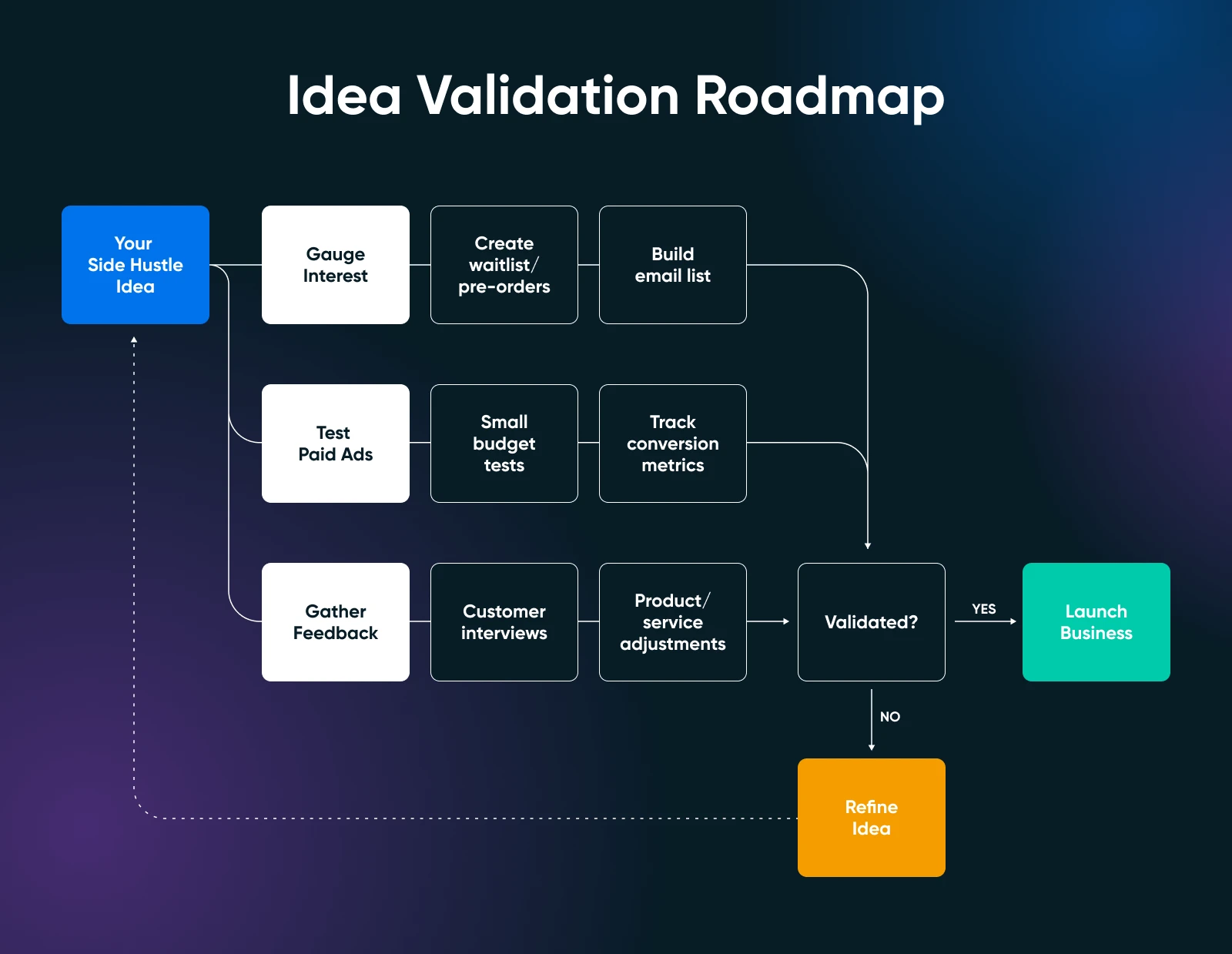When To Turn Your Side Hustle Into a Full-Time Business

Woohoo, it’s 5 p.m.! Your working day is done.
Except, it’s really just beginning.
Around your full-time job, you have this fun side hustle. It doesn’t pay the bills (yet), but you get extra income doing something you love.
Friends and coworkers say you should ditch the 9–5 and go full-time with your side gig. The idea sounds awesome…but can you turn it into a thriving business?
If you’re at this career crossroads, we’re happy to help.
In this post, we’ll guide you through the decision — from validating your side hustle idea to calculating your potential income.
Let’s jump right in!
Are You Ready To Make the Leap?
Before you redraw your whole career path, it’s worth figuring out where you currently stand. Are you ready to launch, or years away?
Start by asking yourself the following questions:
If you mostly answered “Yes,” you’re close. If you mostly answered “No,” you have work to do.
Either way, it’s important to run some preflight checks before committing to takeoff.
Going Full-Time on Your Side Hustle: Fantasy vs. Reality
Picture the scene.
You’re on a tropical beach, sipping something ice-cold. You open your laptop to start work. You could have started at any time; you’re the boss now, remember?
You spend the next few hours working on your business. You’d do much of this work for free, but you’re actually on good money.
Had enough? Time to put your lounger into full recline for the day.
Many side hustlers imagine this would be their working life if they went all-in. For a tiny few, it does turn out that way.
But for the vast majority, running a small business is anything but cocktails in the Caribbean. Some of the harsh realities include:
- You could end up working longer hours: Small business owners usually work longer hours than staff, with 19% racking up 60 hours per week or more.
- …And taking a pay cut: Your hourly wage may take a hit with all that extra work.
- You might have to pay more tax: In many countries, workers on payroll pay less tax than self-employed people running their own businesses. In the U.S., it’s 7.65% on FICA versus 15.3% for the self employed.
- You won’t get employer-provided benefits: You’ll either need to pay for your health insurance and retirement, or lose these benefits.
- You might find it lonely (or noisy): Working from home is comfortable, but it’s definitely different from working in a social office.
Wow, that sounds pretty bad. Why would you want to even consider going full-time?
Well, working for yourself isn’t all doom and gloom. In fact, it can offer some pretty big upsides:
- You choose your schedule: Even if you’re working longer hours, you can still decide when those hours will be — a big bonus for parents and carers.
- You could be doing something more enjoyable: This isn’t guaranteed, but if you choose wisely, you can build a business around your skills and interests.
- That extra work is going toward growing your business “baby”: You’re not working for faceless fat cats anymore. The sense of ownership can feel really rewarding.
- Your earning potential is unlimited: There’s no guaranteed income here, but there’s no cap either. The sky’s the limit!
- You’re likely to feel way more connected to your work: Growing a business is really hard, but the payoff is way better than any corporate promotion.
TL;DR: Turning a side hustle into a full-time business isn’t for everyone. But if you enjoy your side hustle and want control over your working life, it could be your best decision yet.
6 Signs Your Side Hustle Is Ready for Prime Time
Enough with the soul searching. You’ve given it some thought and you’re definitely up for this.
What’s the next step? Well, you need to check whether your side hustle is ready for the step up.
No one can accurately predict whether a new business will succeed or fail. But there are some key signs that you’re on the right track:

1. Your Side Hustle Income Is More Than Extra Cash
When you make extra money through your side hustle, it’s easy to get carried away. The cash boost feels pretty sweet when you have a guaranteed paycheck.
But what if you took away the paycheck? Would that feel like a good full-time income?
Before you jack in the day job, look at your cash flow. Earning twice your current corporate salary puts you in a strong position (remember, you’re covering your own benefits and sick pay).
And that cash flow needs to be consistent. We’re talking six months of receipts or more. Occasional bumper months make you feel like a million dollars, but they don’t represent your average turnover.
If you’re regularly doing these numbers, it’s a strong indicator that your side hustle is ready for the big time!
2. You’re Constantly Turning Down New Clients
Revenue is important — but it doesn’t tell the full story.
Are you making money from one or two clients? Or are you overrun with people asking for your services?
Many freelance workers follow the first model. That’s okay for a while, but you can end up cycling between feast and famine. Going hungry is definitely not a business plan!
In contrast, strong demand for your services or products suggests you could make even more — if only you had the time.
Turning down clients or racking up a huge waiting list is another good sign you should work full-time on your business.
3. You’re Not Relying on Friends and Family
When you’re just starting out, leveraging your network is smart. If your family and friends are talented sales reps, they can provide a constant stream of clients. “Nice work Nana, another sale!”
This can make your side hustle feel like a thriving business. But you could just be surfing the “I know a guy” wave. There’s no way of knowing.
If you’re serious about going full-time with your side hustle, it’s worth proving that your business model works beyond your extended network.
That means:
- Picking up new clients through marketing and ad campaigns.
- Getting positive feedback from customers whom you don’t know personally.
- Doing jobs at full price; no friends and family discount.
- Not relying on personal referrals.
When you’re doing this consistently, you should definitely think about ditching the day job.
4. Your Business Plan Is More Than “Work Longer Hours”
How do you turn a side hustle into a successful business? Working full-time hours is only part of the equation.
People who successfully make the transition tend to have a business plan. They know how they’re going to turn five clients into 50. They know what revenue that will bring in, and how much they will need to spend.
Have you already made this kind of plan? Great work; you’re well on the way to going full-time on your side gig!
5. Your Side Hustle Is Encroaching on Your Day Job
So, your side hustle is booming. In fact, it’s starting to feel like your job is getting in the way. You spend the day thinking about your hustle, rather than focusing on work. The clock can’t move fast enough.
Of course, you might simply hate your job. Or maybe you just enjoy working on something different.
But there’s a good chance that you genuinely love your side hustle. So romantic…
Don’t ignore that enthusiasm. It’s a good sign that your side hustle could be something more.
6. You Have a Financial Safety Net
Here’s the big one. Have you got enough money in the bank to survive a rocky patch?
No matter how carefully you plan, things go wrong. Every founder can recall a period when success looked like a distant point of light at the end of a long, dark tunnel.
Getting through rough times is stressful enough when you’re eating through savings. However, they’re even more stressful without any savings.
Before going full-time, calculate your costs (including health and retirement) and see how long you could last without consistent income. If you can hang on for six months or more, you’re in the right ballpark!
The Next Steps: Validating Your Idea

Hey, you’ve checked most of these boxes! Nice work. That means you’re well-placed to take a huge career step.
At this point, you could jump straight in. Just quit your job today and go full-time. Many people do, and they see varying levels of success.
We’d recommend a slightly more cautious approach. Taking things one step at a time means you’re less likely to make big errors and burn through your cash reserves.
Your first task should be to validate your business idea — seeing whether your plan could work in reality. Here’s your to-do list:
Want to learn more? Visit our complete guide to validating your idea!
Launching Your New Business
Validating your business is like a test run. It allows you to gather information and adjust your approach before the big launch. Data from the validation process can also help you calculate your path forward.
As you prepare for launch day, here are some of the key moves to make:

1. Set a Clear Revenue Goal
As any athlete will tell you, setting a goal gives you something to strive for. Even if you miss the target, you’ll likely do better with something to aim at.
In business, revenue is your game. Set yourself a realistic goal, based on the interest you have seen so far. It can be ambitious, though.
Give yourself a set time frame to achieve your goal, and set a reminder to check your progress after that time has elapsed.
2. Define Your Business Budget
To make your revenue goals mean something, you need to keep control of spending. And that means setting a budget.
Start with the absolute essentials: inventory, taxes, website hosting, and so on. If you still have some headroom, you can tack on fun stuff like equipment upgrades.
As a startup, it’s a good idea to prioritize spending that directly affects growth…just don’t go wild. You don’t have to become a mega-corporation in the first quarter!
3. Build a Support System
Growing a small business from scratch is a lonely task. There’s no boss to take over or coworkers to chip in. Only you can fix the problems.
Except, no one really does it alone. Not successfully, anyway. Every great entrepreneur builds their own support network — mentors, peers, and other professionals.
And that’s not the only reason to reach out.
Business is about connections. Most people prefer to do business with someone they know. And they’re more likely to help an associate than a total stranger.
If you don’t know anyone in your space, now is the time to make friends on LinkedIn and join some local networking groups.
4. Establish a Timeline
After making the decision to launch, it’s easy to let time drift. There’s a lot to do, and you want to get it right.
So, we would suggest putting some dates in your diary:
- When you’re going to launch your new venture.
- When you’re going to quit your day job.
Try not to look too far into the future. The sooner you launch, the sooner you’ll be making money — or finding out that your plan needs to change!
Working Full-Time as a Founder
Turning your side hustle into a full-time business is, in equal parts, exciting and daunting.
It’s not just about leaving your 9–5 behind. It’s about chasing a dream and betting on your ability to make it a reality.
With careful planning, realistic expectations, and a whole heap of determination, you can turn your passion into your livelihood. And at DreamHost, we’re here to help.
When you’re ready to launch, our hosting plans should provide the perfect foundation for your online ambitions. With unlimited bandwidth and 100% uptime guaranteed, the competition doesn’t stand a chance!
Sign up today to get your site ready for action.

